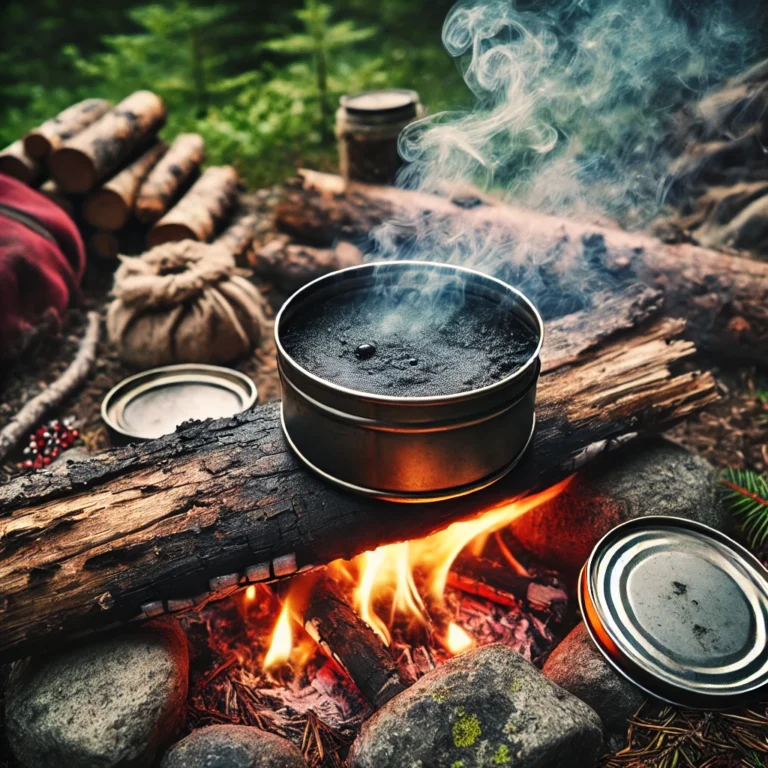Char cloth is one of the most reliable tools you can have in your fire-starting kit. Whether you’re heading out for a camping trip, preparing for an emergency, or honing your bushcraft skills, learning to make and use char cloth is a game-changer. It’s simple to craft, lightweight to carry, and incredibly effective when it comes to starting a fire in challenging conditions. Let’s dive into how you can make and use this survival essential!
What Is Char Cloth?
Char cloth is a fabric, usually made from 100% cotton, that has been turned into a carbonized material through a process called pyrolysis. This transformation makes it incredibly flammable, even with just a tiny spark. Unlike regular tinder, char cloth catches fire quickly and burns long enough to ignite other materials like twigs or kindling.
Think of it as your trusty ignition assistant—perfect for sparking a blaze when you need it most.
How to Make Char Cloth at Home
Creating char cloth is easy, requiring just a few simple materials and a little time. Here’s what you’ll need:
Materials:
- 100% cotton fabric (old t-shirts, denim, or pillowcases work well).
- A metal tin with a lid (like an Altoids tin).
- A heat source (campfire, stove, or even a barbecue grill).
Step-by-Step Instructions:
- Prepare the Fabric: Cut your cotton fabric into small squares or rectangles, about 2-3 inches each.
- Fill the Tin: Place the fabric pieces inside the metal tin. Be sure to leave a little room for airflow but don’t overcrowd it.
- Create Ventilation: Poke a small hole in the lid of the tin. This allows gases to escape during the charring process.
- Heat the Tin: Place the tin on your heat source. As it heats up, smoke will begin to escape from the hole in the lid. This is normal and part of the process.
- Wait for Completion: After 5-15 minutes, the smoke will stop, indicating the charring is complete. Remove the tin from the heat and let it cool completely before opening.
- Inspect Your Char Cloth: Once cooled, check the fabric. It should be black, lightweight, and easy to tear.
Using Char Cloth to Start a Fire
Now that you’ve made your char cloth, it’s time to put it to good use!
Step 1: Gather Your Fire Starting Kit
You’ll need a fire striker (or a ferrocerium rod) and a good supply of tinder. Dry leaves, pine needles, or shredded bark make excellent choices.
Step 2: Prepare the Tinder Nest
Arrange your tinder in a loose “nest” shape. This will help it catch the ember from your char cloth and turn it into flames.
Step 3: Ignite the Char Cloth
- Place a piece of it on a flat surface or hold it with your striker.
- Strike your ferro rod to produce sparks. Aim them directly onto the char cloth.
- When the cloth catches a spark, it will begin to glow red.
Step 4: Transfer the Ember
Carefully place the glowing cloth into your tinder nest and gently blow on it. As the ember spreads, the tinder will ignite, and you’ll have a roaring fire in no time!
Why Char Cloth Is Essential for Preppers and Survivalists
For preppers and outdoor enthusiasts, having a dependable way to start a fire is non-negotiable. Char cloth excels in reliability and portability, making it a staple in survival kits.
- Compact: A small tin of it can last for multiple uses and fits easily into any pack.
- Efficient: It catches even the weakest spark, saving effort and resources.
- Versatile: Works in damp or windy conditions, unlike other tinders that may struggle.
Having the cloth on hand can make all the difference in a survival scenario, whether you’re boiling water, cooking food, or staying warm.
Troubleshooting Common Issues
If your char cloth isn’t working as expected, don’t worry—there’s always a fix!
- Problem: The cloth didn’t ignite.
- Solution: Ensure you’re using 100% cotton fabric. Synthetics won’t char properly.
- Problem: The cloth disintegrates too easily.
- Solution: It may have over-charred. Reduce the heating time during the next batch.
- Problem: Sparks aren’t catching.
- Solution: Check your fire striker technique and ensure the cloth is dry.
Storing and Transporting it
To keep your cloth in top condition, store it in a waterproof container or resealable bag. This protects it from moisture, which can make it less effective. Always carry a backup fire starter like a lighter or matches, but rely on char cloth for those challenging situations where other methods might fail.
Practice Makes Perfect
Fire-starting is a skill that improves with practice. Spend time mastering the art of striking sparks and preparing tinder nests to become confident in your abilities. When you’ve got this skill down, you’ll feel more prepared, self-reliant, and ready to face whatever the great outdoors throws your way.



